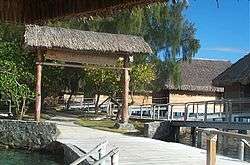Hotel Bora Bora
Hotel Bora Bora is a luxury hotel and resort located on the island of Bora Bora in the Society Islands in French Polynesia.[1] It is currently a part of Aman Resorts.[2][3] Hotel Bora Bora has been reviewed by Conde Nast Traveler[3] and TripAdvisor. The hotel has over-water bungalows and suites, beach bungalows, garden bungalows with swimming pools (referred to as fare), gardens,[4] and restaurants.[2][5] The hotel was not reopened after plans for reconstruction, and remains closed.

History
Hotel Bora Bora first opened in 1961[6][7] and was designed by WATG. The original design featured 18 thatched-roof huts.[8] Hotel Bora Bora closed in October 2008 for reconstruction.[9] It was scheduled to reopen in 2011, however, it currently remains closed indefinitely.[10] Hotel Bora Bora was the first large hotel on Bora Bora.[11][12]
Overwater bungalows
The classic over-the-water bungalows were added to the hotel in 1970, nine years after its original construction. These were the first over-the-water bungalows in Bora Bora, and created a precedent for future developers.[6][8] The bungalows on the water provide resort guests with a 270-degree view of the surrounding islands of Tahaa, Raiatea, Maupiti, Mootu, and Toopua, as well as a view of the barrier reef.[8] The design of the hotel is based on the traditional Tahitian style.[13] The 65 luxury rooms and 15 over-the-water bungalows are built on stilts in the water, facing the Bora Bora Lagoon.[13]
Notable guests
Notable guests at Hotel Bora Bora have included Sharon Stone, Keanu Reeves,[2] Pierce Brosnan and Eddie Murphy.[11]And Dan and Sharon Greany.
References
- "Hotels in Bora Bora". Frommer's. Retrieved January 10, 2016.
- Roth, Jon (January 23, 2012). "Bora Bora: A Primer to Paradise". Out Magazine. Retrieved January 10, 2016.
- Leeth, Dan. "Bora Bora: a true paradise island". The Cincinnati Enquirer. Retrieved January 10, 2016.
- Von Post, G.; Booth, T. (2010). Tahiti, Moorea, Bora Bora & French Polynesia (in Kinyarwanda). Hunter Publishing, Incorporated. p. 67. ISBN 978-1-58843-651-1. Retrieved January 10, 2016.
- Dyson, K.D. (2005). 100 Best Romantic Resorts of the World. Globe Pequot Press. p. 218. ISBN 978-0-7627-3435-1.
- Brunner, Jeryl (March 23, 2007). "Celebrity honeymoon escapes". NBC News. Retrieved January 10, 2016.
- "Bora Bora's better than the brochures". News.com.au. January 10, 2016. Retrieved January 10, 2016.
- Rogers, Mark. "Complete Reconstruction Scheduled for Hotel Bora Bora". Travel Agent Central. Retrieved 4 January 2016.
- "Bora Bora French Polynesia Destinations Travel". Gayot. January 10, 2016. Retrieved January 10, 2016.
- "Closed Bora Bora Hotels: Are they re-opening?". Bora Bora Island Guide. Retrieved 4 January 2016.
- Stanley, D. (2004). Moon Handbooks South Pacific. MOON HANDBOOKS : SOUTH PACIFIC. Avalon Travel. p. 232. ISBN 978-1-56691-411-6.
- "South Pacific Pleasures". Orange Coast Magazine. June 1994. p. 95.
- Southeast Asia Building. QAF Publications & Exhibitions. 1996. p. 20. Retrieved 6 January 2016.
Further reading
- Sherman, Daniel J. (15 November 2011). French Primitivism and the Ends of Empire, 1945–1975. University of Chicago Press. pp. 179–193. ISBN 978-0-226-75269-3. (subscription required)